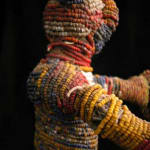Yoruba Beaded Warrior, 19th Century CE - 20th Century CE
Beads
8 x 12.75
PF.5711
Further images
Beads and royalty are closely linked in Africa. For centuries, African rulers accumulated valuable locally made and imported beads. They also controlled their distribution and use. The ownership of large...
Beads and royalty are closely linked in Africa. For centuries, African rulers accumulated valuable locally made and imported beads. They also controlled their distribution and use. The ownership of large quantities of beads, the variety of exquisite beaded clothing and regalia, and the right to display colorful beaded designs distinguish rulers from the rest of the populace.
In Yoruba tradition, strands of beads are the emblems of the gods and symbolic marks of distinction. They are used to signify important political and religious leaders. All the colors have meaning, and all the symbols have meaning. This sculpture of a warrior is covered from head to toe in multicolored beads, generally red, blue, yellow, and white. The warrior stands poised, ready for battle with his club raised in the air. His head is spectacularly crafted: large, bulging eyes; round, open mouth; and arching, raised nose. The beadwork appears simultaneously controlled and haphazard. His torso and legs seem to be beaded with no particular pattern; however, his eyes, mouth, and hand are deliberately ordered. There must exist a deep symbolism behind these colors. Perhaps this figure is a warrior god. Perhaps he is a guardian of the king. Given the importance of beads in Yoruba culture, this sculpture must be as important for what it is as whom it may represents.
In Yoruba tradition, strands of beads are the emblems of the gods and symbolic marks of distinction. They are used to signify important political and religious leaders. All the colors have meaning, and all the symbols have meaning. This sculpture of a warrior is covered from head to toe in multicolored beads, generally red, blue, yellow, and white. The warrior stands poised, ready for battle with his club raised in the air. His head is spectacularly crafted: large, bulging eyes; round, open mouth; and arching, raised nose. The beadwork appears simultaneously controlled and haphazard. His torso and legs seem to be beaded with no particular pattern; however, his eyes, mouth, and hand are deliberately ordered. There must exist a deep symbolism behind these colors. Perhaps this figure is a warrior god. Perhaps he is a guardian of the king. Given the importance of beads in Yoruba culture, this sculpture must be as important for what it is as whom it may represents.









